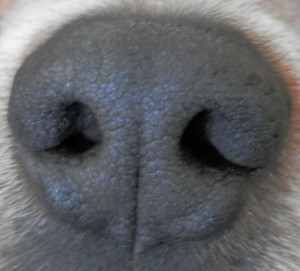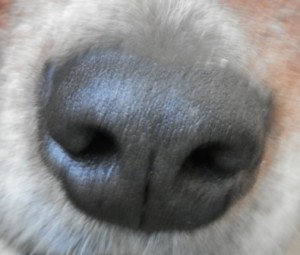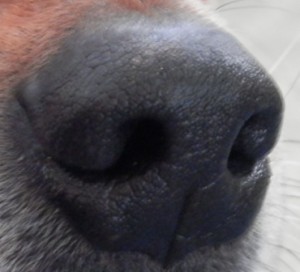“The universe is full of magical things, patiently waiting for our wits to grow sharper.”
~ Eden Philpotts
Have you ever gotten down on the floor on all fours to view the world the way your dog sees it? While you might get a better idea of what your dog sees from that vantage point, your dog isn’t really looking as much as she is smelling, or “viewing” the world through her nose.
You know what I mean if your dog has ever obsessed about a piece of kibble that rolled under the stove, or a crumb that dropped between the sofa cushions. You didn’t even know it was there, but your dog stood vigil and pawed or whined until you fished the tiny tidbit out. Or even worse, your dog scratched relentlessly at the stove or the sofa, trying to fish the morsel out herself. Cattle dogs are notorious for their persistence. My dog Bandit is no exception when he’s trying to rescue a stray crumb.
A dog’s sense of smell is up to 10 million times more sensitive than a human’s. Dogs have 25 to 60 times the number of scent glands that humans have, and more brain space dedicated to their noses. They can smell in parts per trillion, which is like detecting one drop of water out of 20 Olympic swimming pools. It’s no wonder that dogs are following their noses!
The Bark magazine has published fun nose games that you can play with your dog, which are especially useful on days when you’re housebound: http://www.thebark.com/content/k9-nose-work-1. Dog lovers may also train their dogs to follow a scent to compete in tracking events. Of course, dogs already know how to follow scents with their noses, but the object of these events is for the dog and person to work as a team. The dog must follow the scent track that the person has asked the dog to follow, and not get sidetracked by a deer or rabbit that crossed the trail.
It’s interesting to see a dog follow a track laid by a person on snow. While it’s easy for a person to focus on the footprints in the snow, the dog will follow the scent, not the footprints that are much more obvious to those of us who dominantly use our vision. The footprint trail is easier for us to “see” on snow in winter, but the dog doesn’t perceive, or “see”, it that way and still relies on her nose.
Dogs are known for their ability to track down a suspect, find a missing person in the wilderness, detect drugs and bombs, sniff out termites and bedbugs, and even foretell when a person will have a seizure. Researchers have worked to develop electronic noses, or “E-noses”, to mimic how a dog uses its scent receptors to smell. Researchers at the University of California, Santa Barbara, designed a sensor that uses mechanical engineering and chemistry principles to reproduce the canine scent receptors. The sensor feeds information into a computer database, which identifies the molecule that was captured. This device was designed to have the same level of sensitivity as a dog’s nose and was developed to be consistent even when a dog might get tired or distracted. Still, dog noses are the gold standard.
Some of the most inspirational work employing dog noses is in the early detection of cancer. You may recognize animal behaviorist and dog trainer Dina Zaphiris from Animal Planet or the Bonnie Hunt Show. But did you know that her research has shown that dogs are 98% accurate at predicting early stage cancer? Dina’s website, www.dogsdetectcancer.org, references studies on canine olfactory detection of bladder, lung, breast, prostate, ovarian, and colorectal cancers (http://www.dogsdetectcancer.org/category/studies).
Dina works at the InSitu Foundation, the only early detection non-profit group backed by the National Institutes of Health. InSitu’s mission is to save lives with the early detection of cancer through Canine Scent Detection. InSitu trains dogs to detect cancer in humans at its earliest stages, identifying and treating cancer before it becomes life-threatening. Published reports have documented that dogs can detect (sniff) cancer in people at an accuracy rate of 98%, which is more accurate than present day cancer-detection diagnostic medical equipment. Dogs can detect cancer much earlier than modern day machines, thus allowing preventative measures to be applied earlier in a patient’s life. InSitu develops groundbreaking canine techniques in early detection that will lead to saving lives.
At Dina’s website, Australian Shepherd Stewie demonstrates her technique for detecting cancer among healthy and disease controls (http://www.dogsdetectcancer.org/video). And if you scroll down to the short and very compelling video at the bottom of this page, http://www.dogsdetectcancer.org/, you will learn what drives Dina and Stewie to do this work. Dina’s mother discovered her cancer too late, and cancer took her before she was ready.
We have all been affected by cancer in one form or another. At the InSitu Foundation, dogs and people work together to master new early detection techniques to save lives. To contact the InSitu Foundation, learn more about early detection of cancer, and support their efforts to provide Canine Scent Detection for early cancer screening, go to http://www.dogsdetectcancer.org/contact/.
The next time your dog obsesses over a piece of kibble that rolled under the stove, be grateful for the power of that amazing nose, and think about how our dogs perceive the world differently.




Leave a Reply
You must be logged in to post a comment.